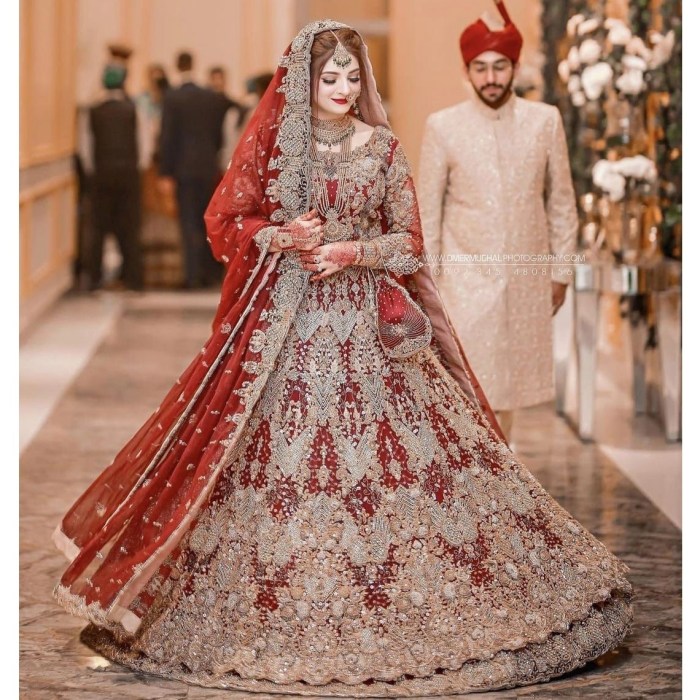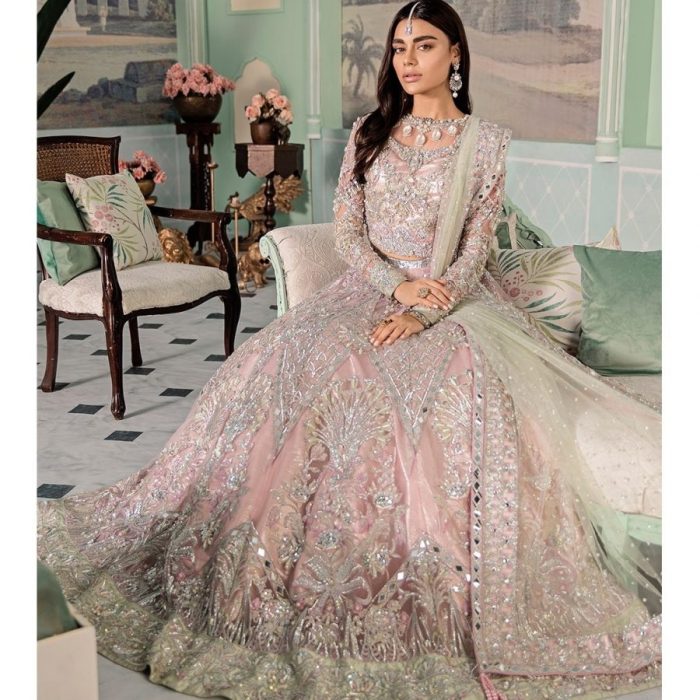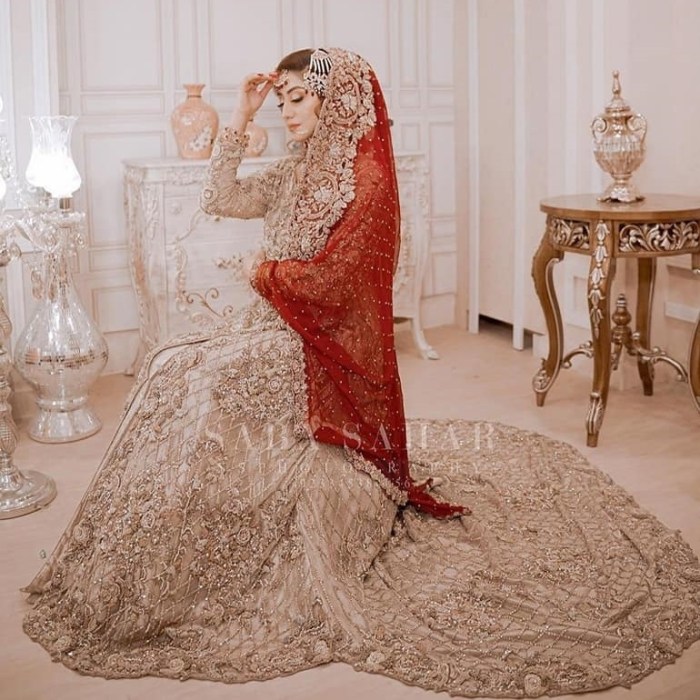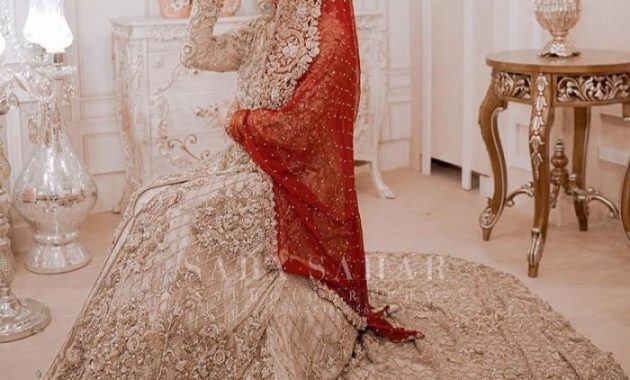Styles of Pakistani Wedding Dresses

Source: pakibridals.com
Wedding dresses pakistani female – Pakistani wedding dresses showcase a rich tapestry of tradition and evolving trends. Over the past fifty years, designs have dramatically shifted, reflecting changing societal norms and global fashion influences. This section explores the evolution, regional variations, and key characteristics of popular styles.
Evolution of Pakistani Wedding Dress Styles
The past fifty years have witnessed a fascinating evolution in Pakistani wedding attire. Traditional styles, heavily embroidered and opulent, have remained staples, but modern interpretations have emerged, incorporating contemporary silhouettes and minimalist aesthetics. The 1970s saw a prevalence of simple, yet elegant, styles. The 80s and 90s brought a surge in heavily embellished designs, often incorporating bold colors and intricate embroidery.
The 21st century has seen a blend of traditional and contemporary, with designers experimenting with fusion styles and modern cuts.
Traditional vs. Modern Pakistani Wedding Dress Designs
Traditional Pakistani wedding dresses, often characterized by elaborate embroidery, rich fabrics, and voluminous silhouettes, are deeply rooted in cultural heritage. Modern designs, while often retaining traditional elements like embroidery, incorporate sleeker silhouettes, lighter fabrics, and a broader color palette. The contrast lies in the level of embellishment and the overall aesthetic – traditional leans towards maximalism, while modern embraces minimalism alongside maximalist styles.
Regional Variations in Pakistani Wedding Attire

Source: pakibridals.com
Regional variations significantly influence Pakistani wedding attire. Sindhi bridal wear often features vibrant colors and intricate mirror work. Punjabi dresses tend to be more elaborate, with heavier embroidery and richer fabrics. Baluchi attire is known for its bold colors and unique embellishments, while dresses from the northern areas incorporate traditional patterns and embroidery techniques.
Fabrics Used in Pakistani Wedding Dresses
The choice of fabric significantly impacts the look and feel of a Pakistani wedding dress. Silk, a timeless favorite, lends a luxurious feel. Chiffon offers a lighter, more flowing silhouette, while velvet adds richness and depth, especially for winter weddings. Other common fabrics include net, organza, and banarasi silk, each offering unique textural and visual qualities.
Comparison of Popular Pakistani Wedding Dress Styles
| Style | Silhouette | Embellishment | Fabric |
|---|---|---|---|
| Sharara | Wide-legged trousers paired with a short kurta or choli | Heavy embroidery, gota patti | Silk, chiffon, velvet |
| Gharara | Similar to sharara but with wider, more flared trousers | Zardozi, sequins, stones | Silk, net, organza |
| Lehnga Choli | Long, flowing skirt paired with a fitted choli (blouse) | Mirror work, aari embroidery | Silk, velvet, banarasi |
| Anarkali | Long, flowing gown with a fitted bodice and flared skirt | Gota patti, zardozi, dabka | Silk, chiffon, net |
Embroidery and Embellishments in Pakistani Wedding Dresses
Embroidery is integral to the artistry and cultural significance of Pakistani wedding dresses. It’s not merely decoration; it tells a story, reflecting regional traditions and the bride’s family heritage. This section delves into the techniques and materials used to create these stunning embellishments.
Significance of Embroidery in Pakistani Wedding Culture
Embroidery is a powerful symbol of heritage and craftsmanship in Pakistani weddings. Intricate patterns and designs are often passed down through generations, representing family history and cultural identity. The skill and artistry involved in creating these embellishments are highly valued, reflecting the bride’s status and the importance of the occasion.
Different Embroidery Techniques
Zardozi, a traditional metal embroidery technique, is renowned for its intricate detailing and luxurious look. Gota patti, using metallic ribbons and laces, creates delicate patterns. Aari embroidery, using a hook needle, is known for its fine lines and intricate designs. Other techniques include dabka, tilla, and mukaish, each contributing unique visual effects.
Embellishments Enhancing Wedding Dress Look
Stones, pearls, and sequins add sparkle and dimension to Pakistani wedding dresses. Strategically placed embellishments can enhance the design’s intricate details and create a visually stunning effect. The type and placement of embellishments are carefully considered to complement the dress’s overall aesthetic and the bride’s personal style.
Visual Representation of Embroidery Styles
Imagine a Lehnga Choli. The bodice is adorned with dense Zardozi embroidery, showcasing floral motifs. The skirt features a cascading pattern of gota patti work, gracefully flowing downwards. Aari embroidery subtly Artikels the neckline and sleeves, adding delicate detail. Mirror work accents the hemline, adding a touch of traditional charm.
Common Embellishment Materials
- Pearls: Add a classic, elegant touch, symbolizing purity and sophistication.
- Stones: Offer brilliance and sparkle, ranging from subtle shimmer to dramatic sparkle.
- Sequins: Provide a glamorous, shimmering effect, ideal for adding movement and shine.
- Gota Patti: Metallic ribbons and laces create delicate patterns and textures.
- Zardozi: Metal threads create intricate designs, symbolizing opulence and luxury.
Colors and Color Combinations in Pakistani Wedding Dresses
Color plays a significant role in Pakistani weddings, often carrying symbolic meanings and reflecting regional traditions. This section explores the cultural significance of specific colors and popular color palettes in modern Pakistani bridal attire.
Cultural Significance of Specific Colors
Red is traditionally associated with auspiciousness and good fortune, often representing the bride’s transition into a new phase of life. Other colors, like green (symbolizing fertility and prosperity) and gold (representing wealth and status), are also frequently incorporated into bridal wear.
Symbolism of Color Combinations
Color combinations in Pakistani wedding dresses can reflect a variety of symbolic meanings. For example, a combination of red and gold signifies prosperity and good fortune, while a combination of green and white symbolizes purity and new beginnings.
Pakistani female wedding dresses often feature intricate embroidery and vibrant colors, reflecting rich cultural heritage. The styles vary widely, from traditional lehngas to more contemporary gowns. For brides seeking a different aesthetic, exploring options like those found at wedding dresses manhattan ks might offer a fresh perspective, showcasing contrasting design elements. Ultimately, the perfect dress reflects the bride’s personal style, whether inspired by Pakistani traditions or other influences.
Popular Color Palettes in Modern Pakistani Wedding Attire
Modern Pakistani brides often opt for a wider range of colors, including pastels, jewel tones, and even monochrome palettes. Shades of blush pink, ivory, and champagne are increasingly popular, reflecting a shift towards softer, more contemporary aesthetics. However, vibrant colors like red, fuchsia, and teal still remain highly sought after.
Vibrant vs. Muted Colors
While vibrant colors have long been a staple of traditional Pakistani wedding attire, a growing trend is towards softer, more muted tones. Muted colors offer a more subtle elegance, while vibrant colors add a bold and celebratory touch. The choice often depends on personal preference and the overall wedding theme.
Modern Pakistani Bride’s Color Palette Suggestion
- Primary Color 1: Dusty Rose – A soft, romantic shade that exudes elegance.
- Primary Color 2: Deep Emerald Green – A rich, jewel tone that adds depth and sophistication.
- Primary Color 3: Champagne Gold – A luxurious metallic that complements the other colors beautifully.
- Accent Color 1: Rose Gold – A warm metallic that adds a touch of shimmer.
- Accent Color 2: Burgundy – A deep, rich red that adds a pop of vibrancy.
Accessories and Jewelry with Pakistani Wedding Dresses
Jewelry is an essential element in completing a Pakistani bridal look. It’s more than mere adornment; it’s a statement of cultural heritage, family tradition, and personal style. This section explores the various types of jewelry and their significance.
Importance of Jewelry in Completing a Pakistani Bridal Look, Wedding dresses pakistani female
Jewelry is integral to the overall aesthetic of a Pakistani bride’s attire. It elevates the look, adding sparkle, glamour, and cultural significance. The type and style of jewelry chosen often reflect regional traditions and family heritage.
Different Types of Jewelry Worn
Pakistani brides often adorn themselves with a variety of jewelry, including elaborate necklaces, bangles, earrings, maang tikas (forehead ornaments), and payals (anklet bells). The intricacy and weight of the jewelry can vary depending on regional customs and personal preference.
Regional Variations in Bridal Jewelry
Regional variations in bridal jewelry are significant. Sindhi brides may opt for heavier jewelry with intricate designs, while Punjabi brides might favor a more minimalist approach. Each region’s unique styles reflect its cultural heritage and artistic traditions.
Traditional and Contemporary Jewelry Pieces
Both traditional and contemporary jewelry pieces are often incorporated into a Pakistani bride’s look. Traditional pieces, often passed down through generations, carry sentimental value and cultural significance. Contemporary pieces offer a more modern twist, adding a unique touch to the overall aesthetic.
Hypothetical Bridal Jewelry Set
Imagine a bridal jewelry set featuring a multi-strand necklace with intricate gold work and precious stones. Matching jhumkas (bell-shaped earrings) dangle gracefully, and a delicate maang tikka adds a touch of elegance. A set of intricately designed bangles completes the look, adding a touch of traditional flair.
Modern Trends in Pakistani Wedding Dresses: Wedding Dresses Pakistani Female
Modern Pakistani wedding dress designs reflect a fascinating blend of tradition and contemporary influences. Western fashion trends have undoubtedly impacted styles, but designers continue to innovate, preserving the essence of traditional aesthetics.
Influence of Western Fashion
Western fashion has influenced modern Pakistani wedding dresses in various ways, including the incorporation of sleeker silhouettes, minimalist designs, and the use of unconventional fabrics and colors. However, the influence is largely integrated with traditional elements, resulting in a unique fusion.
Emerging Trends in Pakistani Wedding Styles
Minimalist designs are gaining popularity, showcasing the beauty of simple elegance. Fusion styles, blending traditional and Western elements, are also highly sought after. Experimentation with unique necklines, sleeves, and embellishments continues to push boundaries.
Innovation with Traditional Elements

Source: pakibridals.com
Designers are innovating with traditional elements by using modern techniques and incorporating unexpected details. For example, traditional embroidery might be combined with contemporary cuts, or classic silhouettes might be reimagined with unconventional fabrics.
Bridal Looks: Past Decade vs. Current Trends
The past decade has seen a shift from heavily embellished, voluminous styles to a wider range of options, including minimalist, sleek, and fusion styles. While traditional elements remain important, there’s a greater emphasis on personal expression and individual style.
Predictions for Future Trends
Three key predictions for future trends in Pakistani wedding dresses include: a continued rise in sustainable and ethically sourced fabrics, a greater emphasis on personalized and bespoke designs, and further exploration of fusion styles that seamlessly blend tradition with contemporary aesthetics. For example, we’ve already seen a rise in designers incorporating upcycled fabrics or focusing on eco-friendly production methods, reflecting a growing global awareness.
The demand for customized designs, tailored to individual preferences, will likely continue to grow, as will the popularity of hybrid styles that blend traditional Pakistani aesthetics with international influences.
Essential Questionnaire
What is the average cost of a Pakistani wedding dress?
The cost varies greatly depending on the fabric, embellishments, and designer. Prices can range from a few hundred to several thousand dollars.
How long does it typically take to have a Pakistani wedding dress made?
This depends on the complexity of the design and the designer’s workload. It can range from a few weeks to several months.
Where can I find Pakistani wedding dresses for sale or rent?
Many designers offer custom-made dresses, while some boutiques specialize in renting or selling ready-to-wear options. Online marketplaces may also offer a selection.
Can I customize a traditional Pakistani wedding dress design?
Absolutely! Most designers welcome customization requests, allowing you to personalize the design to your preferences.

